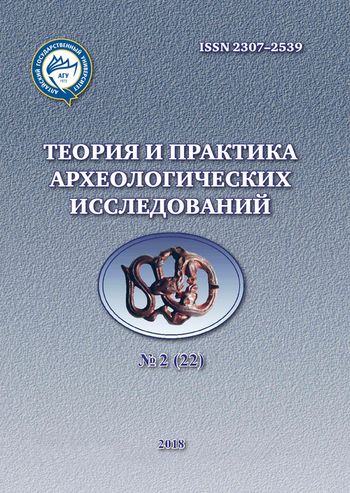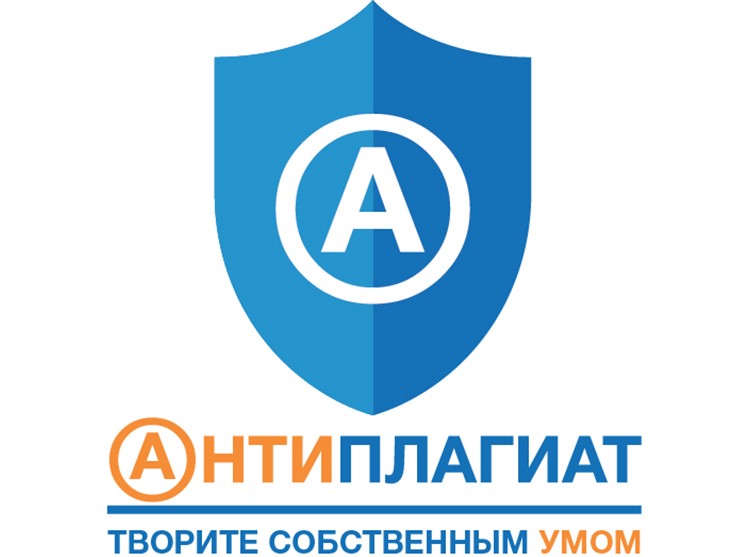THE ABYLAI SETTLEMENT OF THE SAKA TIME IN CENTRAL KAZAKHSTAN
Abstract
The settlement of Abylai is located in the Karkaralinsky district of the Karaganda region, northwest of the Nurken village. The site was discovered in 2004 by A.Z. Beisenov during exploration work. The buildings with stone bases are located on the south – eastern slope of the hill and occupy a meridian strip about100 m long and about 20 m wide. Near the settlement there are two streams. The article provides the data of the excavation 1, laid down in the settlement in 2016. On the area of 208 m2, the remains of nine small stone structures of residential and economic purpose were discovered, with rounded and elongated shapes. More than 1200 fragments from molded vessels with flat bottoms and over 200 stone tools and blanks were found on the excavation area. 143 fragments are the coronals of the vessels. A small part of the disheshave the ornament in the form of small pits and “pearls”. The bulk of tools are made of tuff, granite and sandstone. In total, 2256 bones of animals found on excavation site 1 were studied. Specific definition was made in relation to 754 bones. All definable bones are related to domestic animals: small horned livestock, cattle, horses. Such data of the monument, as features of topography and planning, ceramic complex, are uniquely close to the previously studied settlements of the Saka time of Central Kazakhstan, dated within the 7th – 5th centuries BC.
Downloads
Metrics
No metrics found.
References
Akishev K.A. K probleme proishozhdeniya nomadizma v aridnoi zone drevnego Kazahstana [To the Problem of the Origin of Nomadism in the Arid Zone of Ancient Kazakhstan]. Poiski I raskopki v Kazahstane [Search and Excavations in Kazakhstan]. Alma-Ata : Nauka, 1972. Pp. 31–46 [In Russian]. Акишев К.А. К проблеме происхождения номадизма в аридной зоне древнего Казахстана // Поиски и раскопки в Казахстане. Алма-Ата, 1972. С. 31-46.
Akhiyarov I.K., Beisenov A.Z. Poselenie sakskoi epohi Tyietas v Tsentral’nom Kazahstane [The Touyetas Settlement of the Saka Time of in Central Kazakhstan]. Aktual’nie problemi arheologii Evrazii [Actual Problems of the Archaeology of Eurasia]. Almaty : Institut arheologii im. A.Kh. Margulana, 2016. Pp. 237–244 [In Russian]. Ахияров И.К., Бейсенов А.З. Поселение сакской эпохи Туйетас в Центральном Казахстане //Актуальные проблемы археологии Евразии. Алматы, 2016. С. 237-244.
Beisenov A.Z. Raboti na mogil’nike Nurken-2 [Work on the Nurken-2 Burial Ground]. Istorikokul’turnoe nasledie Saryarki [Historical and Cultural Heritage of Saryarka]. Karaganda : Karagandiskii Gosydarstvennii Universitet, 2007. Pp. 173–198 [In Russian]. Бейсенов А.З. Работы на могильнике Нуркен-2 // Историко-культурное наследие Сарыарки. Караганда, 2007. С. 173–198.
Beisenov A.Z., Loman V.G. Drevnie poseleniya Tsentral’nogo Kazahstana [Ancient Settlements of Central Kazakhstan]. Almaty : Inzhy-Marzhan poligrafiya, 2009. 264 p. [In Russian]. Бейсенов А.З., Ломан В.Г. Древние поселения Центрального Казахстана. Алматы, 2009. 264 с.
Beisenov A.Z. Poseleniya I mogil’niki sakskoi epohi Tsentral’nogo Kazahstana [Settlements and Burial Grounds of the Saka Era of Central Kazakhstan]. Sakskaya kul’tura Saryarki v kontekste izycheniya etnosociokul’tyrnih processov stepnoi Evrazii : sb. naych. st., posvyаchennih pamyati arkheologa K.A. Akisheva [Sakskaya Culture of Saryarka in the Context of the Study of Ethno-Sociocultural Processes of Steppe Eurasia. Collection of Scientific Articles Dedicated to the Memory of Archaeologist K.A. Akishev]. Almaty: Naychno-issledovatel’skiy tsentr istorii I arheologii «Begazy-Tasmola», 2015. Pp. 11–38 [In Russian]. Бейсенов А.З. Поселения и могильники сакской эпохи Центрального Казахстана // Сакская культура Сарыарки в контексте изучения этносоциокультурных процессов степной Евразии. Алматы, 2015. С. 11–38.
Beisenov A.Z. Dromosnie kurgani sakskoi epohi yrochicha Nazar (Tsentral’nii Kazahstan) [Dromosnye Mounds of the Saka Era of the Natural Boundary of Nazar (Central Kazakhstan)]. Samarskii naychnii vestnik [Samara Scientific Bulletin]. Samara, 2016a. №1 (14). Pp. 84–93 [In Russian]. Бейсенов А.З. Дромосные курганы сакской эпохи урочища Назар (Центральный Казахстан) // Самарский научный вестник. 2016а. №1 (14). С. 84–93.
Beisenov A.Z. Dromosnie kurgani sakskoi epohi na reke Zharlу (Tsentral’nii Kazahstan) [Dromatic Mounds of the Saka Time on the Zharly River (Central Kazakhstan)]. Samarskii naychnii vestnik [Samara Scientific Bulletin]. Samara, 2016b. №3 (16). Pp. 78–86 [In Russian]. Бейсенов А.З. Дромосные курганы сакской эпохи на реке Жарлы (Центральный Казахстан)// Самарский научный вестник. 2016б. №3 (16). С. 78–86.
Beisenov A.Z. Zhiliche sakskoi epohi [The Saka Time Dwelling]. Vestn. Tom. gos. un-ta [Bullitin of Tomsk State University]. Tomsk, 2017a. №45. Pp. 72–82 [In Russian]. Бейсенов А.З. Жилище сакской эпохи // Вестник Томского государственного университета. История. 2017а. № 45. С. 72-82.
Beisenov A.Z. Krugloe zhiliche sakskoi epohi [Round House of the Saka Time]. Samarskii naychnii vestnik [Samara Scientific Bulletin]. Samara, 2017b. Vol. 6, №1 (18). Pp. 94–100 [In Russian]. Бейсенов А.З. Круглое жилище сакской эпохи // Самарский научный вестник. – Самара, 2017б, т.6, № 1 (18). С. 94-100.
Beisenov A.Z. Tasmolinskaya kul’tura Saryarki [Tasmolinskaya Culture of Saryarka]. Kazakhstan v sakskyy epohy : kollektivnaya monografiya [Kazakhstan in the Sak Time: Collective Monograph]. Almaty: Institut arkheologii im. A.Kh. Margulana, 2017v. 228 p. [In Russian]. Бейсенов А.З. Тасмолинская культура Сарыарки // Казахстан в сакскую эпоху: коллективная монография. Алматы: Институт археологии им. А.Х. Маргулана, 2017в. 228 с.
Beisenov A.Z. Korgantasskie pogrebeniya v Tsentral’nom Kazakhstane [Korgantas Burials in Central Kazakhstan]. Aktual’nye voprosi arkheologii i etnologii Tsentral’noi Azii : materialy 2’ mezhdunar. naych. konf., posvyachennoi 80-letiyu d.i.n., prof. P.B. Konovalova (Ulan-Ude, 4–6 dekabrya 2017 g.) [Actual Questions of Archaeology and Ethnology of Central Asia: Materials of the 2nd International Scientific Conference Dedicated to the 80th Anniversary of Doctor of Historical Sciences, professor P.B. Konovalov (Ulan-Ude, December 4–6, 2017)]. Ulan-Ude : Buryatskiy nauchnyi tsentr SO RAN, 2017g. Pp. 103–108 [In Russian]. Бейсенов А.З. Коргантасские погребения в Центральном Казахстане // Актуальные вопросы археологии т этнологии Центральной Азии: материалы 2 международной научной конференции, посвященной 80-летию д.и.н., проф. П.Б. Коновалова (г. Улан-Удэ, 4-6 декабря 2017 г.), Улан-Удэ, 2017г. С. 103-108.
Beisenov A.Z. Tasmolinskaya kul’tura Тsentral’nogo Kazakhstana v issledovaniyakh nachala XXI veka [Tasmolinskaya Culture of Central Kazakhstan in the Early 21st Century]. Arkheologiya I davnyaya istoriya Ukrainy. Vyp. 2 (27) [Archaeology and the Long History of Ukraine. Issue. 2 (27)]. Kiev : Institut arkheologii, 2018. Pp. 385–395 [In Russian]. Бейсенов А.З. Тасмолинская культура Центрального Казахстана в исследованиях начала XXI века//Археология и давняя история Украины. Киев, 2018, вып. 2 (27), с. 385-395.
Belousova O.N., Mikhina V.V. Obchi’ kurs petrografii [General Course of Petrography]. M. : Nauka, 1972. 344 p. [In Russian]. Белоусова О.Н., Михина В.В. Общий курс петрографии. М: Наука, 1972. 344 с.
Geologicheskoe stroenie Kazakhstana [Geological Structure of Kazakhstan]. Almaty : Gylym, 2000. 396 p. [In Russian]. Геологическое строение Казахстана. Алматы: Гылым, 2000. 396 с.
Goryachev A.A., Egorova T.A. Poselenie rannego zheleznogo veka v ychel’e Butakovka (yugovostochnaya okraina g. Almaty) [Settlement of the Early Iron Age in the Butakovka Gorge (South-Eastern Outskirts of Almaty)]. Sakskaya kul’tura Saryarki v kontekste izycheniya etnosociokul’tyrnykh processov stepnoi Evrazii : sb. naych. st., posvyachennikh pamyati arkheologa K.A. Akisheva [Sakskaya Culture of Saryarka in the Context of the Study of the Ethno-Sociocultural Processes of Steppe Eurasia: collection of scientific articles dedicated to the Memory of Archaeologist K.A. Akishev]. Almaty: Nauchnoissledovatel’skiy tsentr istorii I arkheologii «Begazy-Tasmola», 2015. Pp. 90–99 [In Russian]. Горячева А.А., Егорова Т.А. Поселение раннего железного века в ущелье Бутаковка (юго-восточная окраина г. Алматы) // Сакская культура Сарыарки в контексте изучения этносоциокультурных процессов Степной Евразии / Сборник научных статей, посвященных памяти археолога К.А. Акишева. Алматы: НИЦИА «Бегазы-Тасмола», 2015. С. 90-99.
Ermolenko L.N. Srednevekovye kamennye izvayaniya kazakhstanskikh stepei (tipologiya, semantika v aspekte voennoi ideologii i traditsionnogo mirovozzrenia) [Medieval Stone Sculptures of Kazakhstan Steppes (Typology, Semantics in the Aspect of Military Ideology and Traditional Worldview)]. Kemerovo: KemGU, 2004. 130 p. [In Russian]. Ермоленко Л.Н. Средневековые каменные изваяния казахстанских степей (типология, семантика в аспекте военной идеологии и традиционного мировоззрения). Кемерово: КемГУ, 2004. 130 с.
Kosincev P.A. Golocenovye ostatki krupnyh mlekopitayuchikh Zapadnoi Sibiri [Holocene Remnants of Large Mammals of Western Siberia]. Sovremennoe sostoyanie I istoriya zhivotnogo mira Zapadno-Sibirskoi nizmennosti : sb. naych. trydov [Current State and History of Fauna of the West Siberian Lowlands: Collection of Scientific Works]. Sverdlovsk : UrO AN SSSR, 1988. Pp. 32–51 [In Russian]. Косинцев П.А. Голоценовые остатки крупных млекопитающих Западной Сибири // Современное состояние и история животного мира Западно-Сибирской низменности / Сб. науч. трудов. Свердловск: УрО АН СССР, 1988. С. 32-51.
Petrograficheskiy slovar’ [Petrographic Dictionary]. M. : Nedra, 1981. 496 p. [In Russian]. Петрографический словарь. М.: Недра, 1981. 496 с.
Khabdulina M.K. Poseleniya rannesakskogo vremeni na r. Selety [Settlements of the Early Saka Time on the Sileti River]. Stepnaya tsivilizatsiya Vostochnoi Eurasii. T. 1. Drevnie epokhi. [Steppe Civilization of Eastern Eurasia. Vol. 1. Ancient Epochs]. Astana : Kul’ Tegin, 2003. Pp. 189–214 [In Russian]. Хабдулина М.К. Поселения раннесакского времени на р. Селеты // Степная цивилизация Восточной Евразии. Т. 1. Древние эпохи. Астана, 2003. С. 189-214.
Benecke N. Iron Age economy of the Inner Asian steppe. A bioarchaeological perspective from the Talgar Region in the Ili River Valley (Southeastern Kazakhstan) // Eurasia Antiqua №9. 2003. Рр. 63-84.
Eisenmann V. Comparative osteology of modern and fossil horses, half-asses, and asses,. In Meadow, RH, Uerpmann H-P. (Eds.) // Equids in the Ancient World, Volume I. Dr. Ludwig Reichert Verlag, Wiesbaden, 1986. Рp. 67-116.
Von den Driesch A. A guide to the measurement of animal bones from archaeological sites / A. Von den Driesch // Peabody Mus. Bull. 1976. № 1. 136 p.
Theory and Practice of Archaeological Research is a golden publisher, as we allow self-archiving, but most importantly we are fully transparent about your rights.
Authors may present and discuss their findings ahead of publication: at biological or scientific conferences, on preprint servers, in public databases, and in blogs, wikis, tweets, and other informal communication channels.
Theory and Practice of Archaeological Research allows authors to deposit manuscripts (currently under review or those for intended submission to ABS) in non-commercial, pre-print servers such as ArXiv.
Authors who publish with this journal agree to the following terms:
- Authors retain copyright and grant the journal right of first publication with the work simultaneously licensed under a Creative Commons Attribution License (CC BY 4.0) that allows others to share the work with an acknowledgement of the work's authorship and initial publication in this journal.
- Authors are able to enter into separate, additional contractual arrangements for the non-exclusive distribution of the journal's published version of the work (e.g., post it to an institutional repository or publish it in a book), with an acknowledgement of its initial publication in this journal.
- Authors are permitted and encouraged to post their work online (e.g., in institutional repositories or on their website) prior to and during the submission process, as it can lead to productive exchanges, as well as earlier and greater citation of published work (See The Effect of Open Access).








2.jpg)




